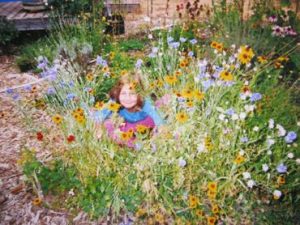
Author’s daughter Grace Kaplowitz communing with nature.
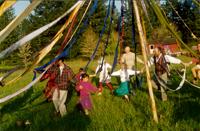
LV members and friends dancing around a Maypole on Beltane.
Author: Karin Iona Sundberg
Published in Communities Magazine Issue #159
Soon after moving to Lost Valley Educational Center, an intentional community in Dexter, Oregon, I found one member particularly difficult to resonate with. I did what came naturally—which was to avoid conflict at all costs. I shrank from her sharp edges and worked to soften my own; to see her as beautiful, to understand her perspective, to give her latitude.
One day she said to me, “You know, Karin, I have my part it in too.” She asked me to interact with her more, to tell her the truth. She wanted connection and understanding, perhaps to know why people reacted to her as they did. I still felt tentative, but began to offer her my perspective. Though we never became the closest of friends, over time we forged a more trusting bond. I appreciated her strength, and she responded to my warmth. Her willingness to ask for feedback took courage; she created an opening, and light shone in.
We all need each other to see ourselves clearly. In many communities, even those that are spiritually based, we don’t always connect from a place of honesty. By honesty I don’t mean sharing every judgment. Judgment isn’t honest, it’s delusion—it’s seeing someone else through harsh eyes rather than owning our own discomfort. But to share who we are, what our fears or dreams are, to say the hard thing that makes us feel vulnerable—especially when a lot is at stake—from a caring, responsible place within…can make or break the well-being of family or community. We have to risk. We have to keep our relationships clear.
A community offers a container into which the members can bring specific practices. This works best if everyone is aligned. At Lost Valley, when we brought in new practices meant to connect us more deeply, those who were not aligned left over the next couple years. This was not an easy period, though in retrospect it seems everyone flourished on their respective paths. During the transition, a core group of members held the vision of a connected, enterprising, abundant, healthy community, and over time, we settled into a new rhythm, like spring burgeoning after winter storms.
We learned that having weekly well-being meetings—where we came together to share our personal challenges and triumphs, lessons we were learning about ourselves, and ways we could use support—was vital to having effective business meetings (where we’d make community decisions and manage the conference center).
Without well-being meetings, our business meetings could become bleak and dysfunctional when previously unexpressed emotions clouded issues and made it hard to come to resolution. Any topic could incite stubbornness and resistance, and the fear of not being heard would have members pushing for their own private agendas. By keeping communication clear on a personal level, fewer issues became contentious and irresolvable. We were better able to listen to and understand one another.
We held regular Naka-Ima workshops in which many members of the community participated. Naka-Ima is a practice of honesty and letting go of attachments. One of the founders of Naka-Ima, Jaime Campbell, says, “Nothing can prepare us more fully for a harmonious future than the activity of unraveling the emotional and ideological patterns which make up our own psyches.” [Naka-Ima inspired other courses, including Solsara: the practice of opening, which is facilitated by a former member of Lost Valley and held regularly in Eugene and Portland.]
We also learned from other practices: consensus process, nonviolent communication, meditation, and we brought in mediators for sticky issues and to help us with overall visioning. In circles we passed a talking stick.
Community Wisdom Lesson 1: Deepen connections with others. In community there is more at stake and more opportunity to come together to resolve challenges. Utilize the potential to learn from one another; emphasize the importance of kind honesty and keeping resentments clear. Experiment with group dynamics.
“My people the Dagara people live in community. Their life blood is ritual. As a child I never thought much about ritual and its implications. I thought everything was a given and everywhere I went life would be the same as in my little Village.” She was asked by the elders of her community to take their teachings to the West. This separation from her roots was shattering. Over time she found her strength, her place, and her power within the radically different culture of the United States by sharing and leading rituals. She says, “My experience being away from my community has taught me that the close relationship I experienced with community was essential for the growth of human Spirit and necessary for peace within the community.”
At Lost Valley we sang before meals and when we gathered together each morning before working in the garden. Singing is a simple and powerful way to uplift and literally harmonize the energy of a group. We celebrated the changing seasons by performing rituals on the traditional Celtic holidays and cross holidays (Solstices, Equinoxes, and Imbolc, Beltane, Lammas, and Samhain). On birthdays we exchanged coupons, or promise notes as gifts. Everyone, even the youngest children, would write down (or have helping writing) what they would give—childcare, going for a walk in the woods, a massage, a movie, doing the person’s dishes for a week. We had rituals for transitions—initiations into being an elder or a healer, for children letting go of nursing, for becoming godparents, for grieving miscarriage or divorce.
Within the members we had various interests and individual practices, and in addition our conference center hosted groups of different faiths; we were living in the midst of many traditions—Buddhist, pagan, Native American, Jewish, Christian. This gave us all an opportunity to keep expanding our own understanding of others.
Community Wisdom Lesson 2: Deepen connection with spirit. Learn from the wisdom of indigenous cultures; use rhythmic celebrations to infuse the community with a sense of the sacred within everyday life. Have fun together.
Other perennial rhythms could be counted on as well. Like a well-tuned orchestra, each living thing presented itself with perfect timing, springing from the ground or bursting into bloom…Shasta daisies, morel mushrooms, the rare Lady’s Slipper orchids, maple tree blossoms, the slender purple irises that showed up along a tiny seasonal water catchment pond. They all could be reckoned on to rise up in a steady succession, and then recede back to the earth, quiet until their time came again.
Of course in cities we have access to and awareness of the changing seasons. But there was something remarkable about living on land year after year, having an expanse of nature outside the front door, walking through the meadow to the office rather than commuting, especially while paying attention, practicing gratitude, and working to improve the environment. Planting gardens, fixing infrastructure, creating sacred spaces, being committed to helping a place and community to flourish—all these gave an irreplaceable sense of being rooted.
One day walking along the drive I came to a deep recognition that Lost Valley was shaping me into who I was—as if I were an extension, or outcome, of this blend of land and community. I marveled at the thought: I am Karin of Lost Valley, as if I were springing forth like the growing things around me.
This was not an experience I’ve had before or since, and yet it feels like a vital missing link in our culture. I’m not sure how to create it, though one aspect seems to be to stay in one place long enough to develop an intimate relationship with our surroundings.
Community Wisdom Lesson 3: Deepen our connection with place; commit to knowing it well. Watch the seasons unfold; tune in to the beauty of nature. Notice how the place where you are (family, work, neighborhood, community) shapes and grows you—that you are “of” a place—and how this elicits an innate responsibility, a sense of stewardship.
Governance
Consensus is a powerful tool, but perhaps not for every decision a community needs to make. Create a management team that listens to members’ considerations and makes decisions on certain issues. Establish a Board of Directors to get support and outside perspectives.
Membership
Accentuate the positive impact of new members and mitigate the challenging aspects. Be clear where (on what physical areas and what types of projects) new members can focus their enthusiasm. Decide when a member has voting rights. There is wisdom in knowing why and how systems were designed before changing them.
Also, consider leaving the long-term vision creation to long-term members. In our community there were times when new members had a huge impact on our direction or commitments, and then left within the year.
Vision
Work to create a clear, succinct, specific vision for the community. The broader the vision is, the harder it is to run a business or create alignment within a group. Having a clearly defined vision can help guide community members in making decisions on directions, opportunities, and incoming people.
Know that even when it’s clearly stated, each individual will likely have his or her own interpretation of the vision. In this case, the work of Benjamin Zander, author of The Art of Possibility, may be helpful. When we make mistakes or clash with one another, Benjamin advocates that we throw our hands up in the air, smile, and say “How fascinating!” (In the office where I work we have chopsticks with little flags—with the words “How fascinating” on them—that we wave around when we need reminding of these helpful attitudes.)
Struggles and Scarcity Mentality
For unresolved struggles, find a practice or practitioner that can help. There are countless options for mediation, workshops, counseling. Be courageous; be vulnerable.
To resolve lack mentality, bring in trainings for the overall business or individuals if needed—trade retreat time or workshop space for small business coaching for members to create their own businesses. The financial health of each individual impacts the whole. Much free information is available online from small business coaches as well.
Within community and decision-making groups, create study groups to focus on and support abundance. Work on unhelpful subconscious beliefs. Our environment has a big impact on us. If each individual is doing their own work to create an attitude of abundance, this will contribute to the group.
Interacting within community, whether it’s a family unit, an organization, or an intentional community, can be rigorous work. Yet I also believe that community is our heritage; that creating community wherever we are is life-giving and essential both for our highest good individually and for our culture. Through community we can create openings—in ourselves, into issues, with nature, beyond the mind—and let light shine in.

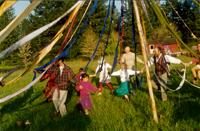







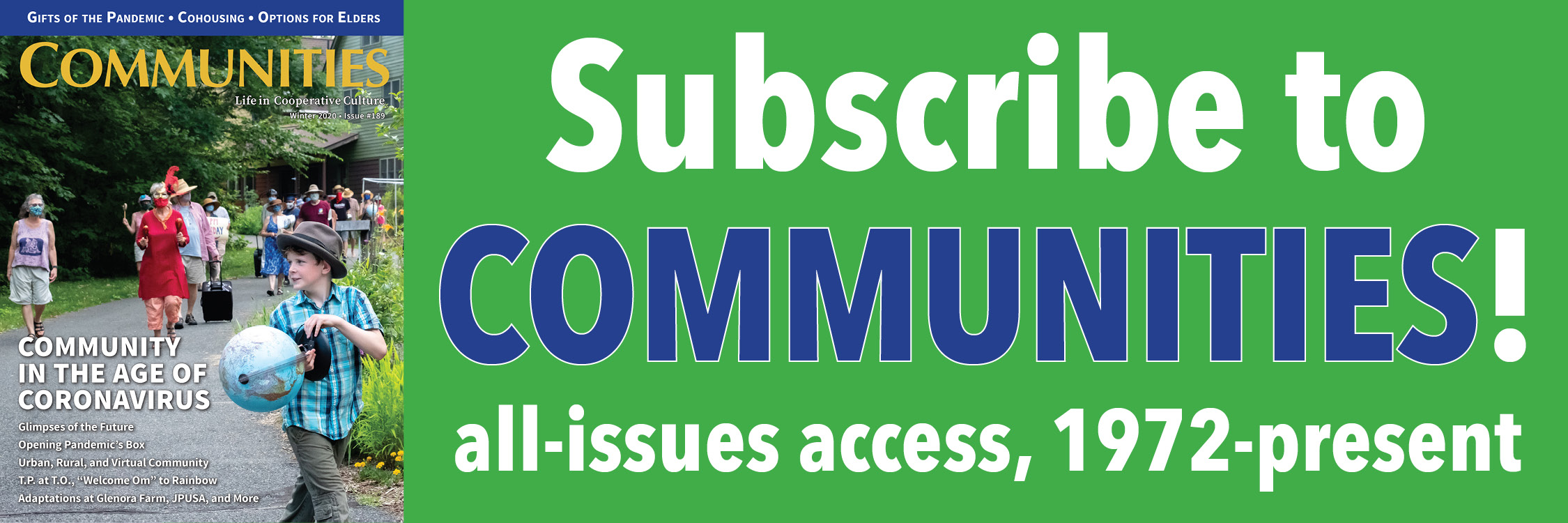










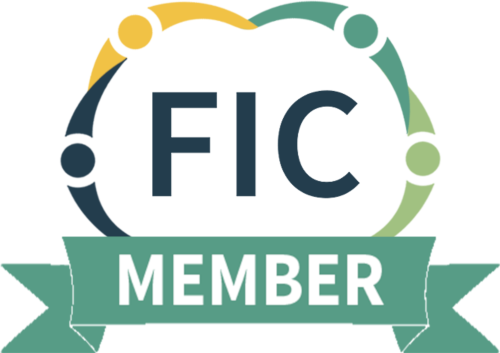

paulborn
The wisdom and warmth in this article really made my day. We can learn so much from those who live or have lived intentionally in community.